How Can Urban Regeneration Reduce Carbon Emissions? A Bibliometric Review
Abstract
1. Introduction
2. Materials and Methods
2.1. Data Collection and Search Strategy
- Topics were scanned using the above-mentioned search rule in the English language. In order to retrieve enough documents for a comprehensive analysis, the time span of the search was set from 1 January 1990 to 21 March 2023, resulting in 443 papers (document types including Articles, Review Articles, Proceeding Papers, Letters, and Early Access);
- Then, proceeding papers and letters were rejected, leaving 430 papers;
- To guarantee the accuracy and relevance of the literature analysis, the abstracts of each paper were examined to weed out irrelevant ones, such as literature in the categories of archaeology, microbiology, limnology, chemical engineering, etc. Finally, 231 papers (the first of which appeared in 2001) were selected for bibliometric analysis and further discussions.
2.2. Bibliometric Approach
- Yearly trend. The indicator reflects the number of articles published each year which shows the trend of research interest in the field;
- Output by countries. The indicator shows the distribution of publications contributed by each country in this research field;
- Co-occurrence analysis of keywords. A co-occurrence analysis of keywords is used to visualize the relationship network among topics of the existing research. The analysis was performed by calculating the frequency in which two keywords co-occur in the same paper, indicating the association structure of keywords in the current research [27];
- Keywords clustering and timeline analysis. Keywords clustering analysis refers to creating a clustering map to show categories of research topics. Each cluster in the map represents a significant branch or direction of current academia. The more often keywords appear together, the stronger the association and similarity between them, so they are more likely to belong to the same cluster. The names of clusters are determined by the software utilizing the log-likelihood ratio (LLR) [28] of the software. The modularity value is used to assess the clustering quality with a higher value indicating a more well-defined cluster. To depict the progression of research topics, keywords after the clustering are placed on a horizontal timeline, sorted by the year in which the keyword first appeared;
- Keywords burst citation. This indicator aims to calculate the burst strength of keywords as those with a sudden increase in the usage frequency signify a research hotspot in the field of study.
3. Bibliometric Results
3.1. Yearly Trend and Output by Countries
3.2. Co-Occurrence Analysis of Keywords
3.3. Keywords Clustering and Timeline Analysis
3.4. Keywords Burst Citation
4. Discussion
4.1. Key Regeneration Elements in CO2 Reduction
4.2. Urban Regeneration Strategies to Reduce Carbon Emissions
4.3. Methodologies Utilized in the Reviewed Articles
4.4. Research Trend and Agenda
5. Conclusions
Author Contributions
Funding
Data Availability Statement
Acknowledgments
Conflicts of Interest
References
- Luo, X.; Ren, M.; Zhao, J.; Wang, Z.; Ge, J.; Gao, W. Life cycle assessment for carbon emission impact analysis for the renovation of old residential areas. J. Clean. Prod. 2022, 367, 132930. [Google Scholar] [CrossRef]
- Liu, Z.; Fang, C.; Sun, B.; Liao, X. Governance matters: Urban expansion, environmental regulation, and PM2.5 pollution. Sci. Total Environ. 2023, 876, 162788. [Google Scholar] [CrossRef]
- Grimm, N.B.; Faeth, S.H.; Golubiewski, N.E.; Redman, C.L.; Wu, J.; Bai, X.; Briggs, J.M. Global change and the ecology of cities. Science 2008, 319, 756–760. [Google Scholar] [CrossRef]
- Lou, Y.; Jayantha, W.M.; Shen, L.; Liu, Z.; Shu, T. The application of low-carbon city (LCC) indicators—A comparison between academia and practice. Sustain. Cities Soc. 2019, 51, 101677. [Google Scholar] [CrossRef]
- Bai, X.; Dawson, R.; Ürge-Vorsatz, D.; Delgado, G.; Barau, A.S.; Dhakal, S.; Dodman, D.; Leonardsen, L.; Masson-Delmotte, V.; Roberts, D.C.; et al. Six research priorities for cities and climate change. Nature 2018, 555, 19–21. [Google Scholar] [CrossRef]
- Heiskanen, E.; Johnson, M.; Robinson, S.; Vadovics, E.; Saastamoinen, M. Low-carbon communities as a context for individual behavioural change. Energy Policy 2010, 38, 7586–7595. [Google Scholar] [CrossRef]
- Du, X.; Shen, L.; Ren, Y.; Meng, C. A dimensional perspective-based analysis on the practice of low carbon city in China. Environ. Impact Assess. Rev. 2022, 95, 106768. [Google Scholar] [CrossRef]
- Ruming, K. Urban Regeneration in Australia: Policies, Processes and Projects of Contemporary Urban Change; Routledge: London, UK, 2018. [Google Scholar]
- Yung, E.H.K.; Chan, E.H.W. Implementation challenges to the adaptive reuse of heritage buildings: Towards the goals of sustainable, low carbon cities. Habitat Int. 2012, 36, 352–361. [Google Scholar] [CrossRef]
- Lai, L.W.; Chau, K.W.; Cheung, P.A.C. Urban renewal and redevelopment: Social justice and property rights with reference to Hong Kong’s constitutional capitalism. Cities 2018, 74, 240–248. [Google Scholar] [CrossRef]
- Fujino, Y.; Noguchi, T. Stock Management for Sustainable Urban Regeneration; Springer Science & Business Media: New York, NY, USA, 2008; Volume 4. [Google Scholar]
- Ercan, M.A. Challenges and conflicts in achieving sustainable communities in historic neighbourhoods of Istanbul. Habitat Int. 2011, 35, 295–306. [Google Scholar] [CrossRef]
- Roberts, P. The evolution, definition and purpose of urban regeneration. In Urban Regeneration: A Handbook; SAGE Publications Ltd.: Newbury Park, CA, USA, 2000; Volume 1, pp. 9–36. [Google Scholar]
- Zheng, H.W.; Shen, G.Q.; Wang, H. A review of recent studies on sustainable urban renewal. Habitat Int. 2014, 41, 272–279. [Google Scholar] [CrossRef]
- Kohler, N.; Hassler, U. The building stock as a research object. Build. Res. Inf. 2002, 30, 226–236. [Google Scholar] [CrossRef]
- Liu, Z.; Guan, D.; Crawford-Brown, D.; Zhang, Q.; He, K.; Liu, J. A low-carbon road map for China. Nature 2013, 500, 143–145. [Google Scholar] [CrossRef]
- Skea, J.; Nishioka, S. Policies and practices for a low-carbon society. Clim. Policy 2008, 8 (Suppl. 1), S5–S16. [Google Scholar] [CrossRef]
- Sovacool, B.K.; Cabeza, L.F.; Pisello, A.L.; Colladon, A.F.; Larijani, H.M.; Dawoud, B.; Martiskainen, M. Decarbonizing household heating: Reviewing demographics, geography and low-carbon practices and preferences in five European countries. Renew. Sustain. Energy Rev. 2021, 139, 110703. [Google Scholar] [CrossRef]
- Zhang, R.B.; Zhong, C.B. Can the adjustment and renovation policies of old industrial cities reduce urban carbon emissions?— Empirical analysis based on Quasi-Natural experiments. Int. J. Environ. Res. Public Health 2022, 19, 6453. [Google Scholar] [CrossRef]
- Yekyeong, S. TOD as a rail integrated urban regeneration strategies of Old City through case study about Toyama Station and surroundings area in Japan. In Proceedings of the Computer Applications for Software Engineering, Disaster Recovery, and Business Continuity: International Conferences, ASEA and DRBC 2012, Held in Conjunction with GST 2012, Jeju Island, Republic of Korea, 28 November–2 December 2012; Proceedings; Springer: Berlin/Heidelberg, Germany, 2012. [Google Scholar]
- van Doren, D.; Driessen, P.P.; Runhaar, H.A.; Giezen, M. Learning within local government to promote the scaling-up of low-carbon initiatives: A case study in the City of Copenhagen. Energy Policy 2020, 136, 111030. [Google Scholar] [CrossRef]
- Garriga, S.M.; Dabbagh, M.; Krarti, M. Optimal carbon-neutral retrofit of residential communities in Barcelona, Spain. Energy Build. 2020, 208, 109651. [Google Scholar] [CrossRef]
- Raihan, A.; Begum, R.A.; Said, M.N.M.; Abdullah, S.M.S. Climate change mitigation options in the forestry sector of Malaysia. J. Kejuruter. 2018, 1, 89–98. [Google Scholar]
- Fahlstedt, O.; Temeljotov-Salaj, A.; Lohne, J.; Bohne, R.A. Holistic assessment of carbon abatement strategies in building refurbishment literature—A scoping review. Renew. Sustain. Energy Rev. 2022, 167, 112636. [Google Scholar] [CrossRef]
- Wang, H.; Liu, N.; Chen, J.; Guo, S. The relationship between urban renewal and the built environment: A systematic review and bibliometric analysis. J. Plan. Lit. 2022, 37, 293–308. [Google Scholar] [CrossRef]
- Chen, C. CiteSpace: A Practical Guide for Mapping Scientific Literature; Nova Science Publishers Hauppauge: Hauppauge, NY, USA, 2016. [Google Scholar]
- Chen, C. CiteSpace II: Detecting and visualizing emerging trends and transient patterns in scientific literature. J. Am. Soc. Inf. Sci. Technol. 2006, 57, 359–377. [Google Scholar] [CrossRef]
- Bautista-Puig, N.; Benayas, J.; Mañana-Rodríguez, J.; Suárez, M.; Sanz-Casado, E. The role of urban resilience in research and its contribution to sustainability. Cities 2022, 126, 103715. [Google Scholar] [CrossRef]
- Conejos, S.; Langston, C.; Smith, J. AdaptSTAR model: A climate-friendly strategy to promote built environment sustainability. Habitat Int. 2013, 37, 95–103. [Google Scholar] [CrossRef]
- Kleinberg, J. Bursty and hierarchical structure in streams. Data Min. Knowl. Discov. 2003, 7, 373–397. [Google Scholar] [CrossRef]
- Chen, C.; Hu, Z.; Liu, S.; Tseng, H. Emerging trends in regenerative medicine: A scientometric analysis in CiteSpace. Expert Opin. Biol. Ther. 2012, 12, 593–608. [Google Scholar] [CrossRef]
- Dixit, M.K.; Fernández-Solís, J.L.; Lavy, S.; Culp, C.H. Need for an embodied energy measurement protocol for buildings: A review paper. Renew. Sustain. Energy Rev. 2012, 16, 3730–3743. [Google Scholar] [CrossRef]
- Power, A. Does demolition or refurbishment of old and inefficient homes help to increase our environmental, social and economic viability? Energy Policy 2008, 36, 4487–4501. [Google Scholar] [CrossRef]
- Juan, Y.K.; Gao, P.; Wang, J. A hybrid decision support system for sustainable office building renovation and energy performance improvement. Energy Build. 2010, 42, 290–297. [Google Scholar] [CrossRef]
- Galvin, R. Thermal upgrades of existing homes in Germany: The building code, subsidies, and economic efficiency. Energy Build. 2010, 42, 834–844. [Google Scholar] [CrossRef]
- D’agostino, D.; Zangheri, P.; Castellazzi, L. Towards nearly zero energy buildings in Europe: A focus on retrofit in non-residential buildings. Energies 2017, 10, 117. [Google Scholar] [CrossRef]
- Hashempour, N.; Taherkhani, R.; Mahdikhani, M. Energy performance optimization of existing buildings: A literature review. Sustain. Cities Soc. 2020, 54, 101967. [Google Scholar] [CrossRef]
- International Energy Agency. 2013. Available online: https://www.eifer.kit.edu/ (accessed on 26 March 2023).
- China Association of Building Energy Efficiency (CABEE). 2021. Available online: https://www.cabee.org/site/content/24021,html (accessed on 26 March 2023).
- Mastrucci, A.; Marvuglia, A.; Benetto, E.; Leopold, U. A spatio-temporal life cycle assessment framework for building renovation scenarios at the urban scale. Renew. Sustain. Energy Rev. 2020, 126, 14. [Google Scholar] [CrossRef]
- Wrålsen, B.; O’Born, R.; Skaar, C. Life cycle assessment of an ambitious renovation of a Norwegian apartment building to nZEB standard. Energy Build. 2018, 177, 197–206. [Google Scholar] [CrossRef]
- Gillott, C.; Davison, B.; Densley Tingley, D. Drivers, barriers and enablers: Construction sector views on vertical extensions. Build. Res. Inf. 2022, 50, 909–923. [Google Scholar] [CrossRef]
- Teng, Y.; Li, K.; Pan, W.; Ng, T. Reducing building life cycle carbon emissions through prefabrication: Evidence from and gaps in empirical studies. Build. Environ. 2018, 132, 125–136. [Google Scholar] [CrossRef]
- Foster, G.; Kreinin, H. A review of environmental impact indicators of cultural heritage buildings: A circular economy perspective. Environ. Res. Lett. 2020, 15, 14. [Google Scholar] [CrossRef]
- Caputo, P.; Costa, G.; Ferrari, S. A supporting method for defining energy strategies in the building sector at urban scale. Energy Policy 2013, 55, 261–270. [Google Scholar] [CrossRef]
- European Institute for Energy Research (EIFER). 2012. Available online: https://www.eifer.kit.edu/ (accessed on 26 March 2023).
- Badescu, V.; Sicre, B. Renewable energy for passive house heating Part I. Building description. Energy Build. 2003, 35, 1077–1084. [Google Scholar] [CrossRef]
- Knuutila, M.; Kosonen, A.; Jaatinen-Värri, A.; Laaksonen, P. Profitability comparison of active and passive energy efficiency improvements in public buildings. Energy Effic. 2022, 15, 19. [Google Scholar] [CrossRef]
- Amoruso, F.M.; Schuetze, T. Hybrid timber-based systems for low-carbon, deep renovation of aged buildings: Three exemplary buildings in the Republic of Korea. Build. Environ. 2022, 214, 28. [Google Scholar] [CrossRef]
- Deakin, M.; Campbell, F.; Reid, A. The mass-retrofitting of an energy efficient-low carbon zone: Baselining the urban regeneration strategy, vision, masterplan and redevelopment scheme. Energy Policy 2012, 45, 187–200. [Google Scholar] [CrossRef]
- Sobrino, N.; Monzon, A. Management of urban mobility to control climate change in cities in Spain. Transp. Res. Rec. 2013, 2375, 55–61. [Google Scholar] [CrossRef]
- Lehmann, S. Low carbon districts: Mitigating the urban heat island with green roof infrastructure. City Cult. Soc. 2014, 5, 1–8. [Google Scholar] [CrossRef]
- Li, Q.; Zhu, Y.; Zhu, Z. Calculation and optimization of the carbon sink benefits of green space plants in residential areas: A case study of Suojin Village in Nanjing. Sustainability 2023, 15, 15. [Google Scholar] [CrossRef]
- Lozano-García, B.; Francaviglia, R.; Renzi, G.; Doro, L.; Ledda, L.; Benitez, C.; González-Rosado, M.; Parras-Alcántara, L. Land use change effects on soil organic carbon store. An opportunity to soils regeneration in Mediterranean areas: Implications in the 4p1000 notion. Ecol. Indic. 2020, 119, 106831. [Google Scholar] [CrossRef]
- Spessato, L.; Bedin, K.C.; Cazetta, A.L.; Souza, I.P.; Duarte, V.A.; Crespo, L.H.; Pontes, R.M.; Almeida, V.C. KOH-super activated carbon from biomass waste: Insights into the paracetamol adsorption mechanism and thermal regeneration cycles. J. Hazard. Mater. 2019, 371, 499–505. [Google Scholar] [CrossRef] [PubMed]
- Lehmann, S. Low Carbon Cities: Transforming Urban Systems; Routledge: London, UK, 2014. [Google Scholar]
- Grace, J. Understanding and managing the global carbon cycle. J. Ecol. 2004, 92, 189–202. [Google Scholar] [CrossRef]
- Bolin, B. The carbon cycle. Sci. Am. 1970, 223, 124–135. [Google Scholar] [CrossRef]
- Wigley, T.M.; Schimel, D.S. The Carbon Cycle; Cambridge University Press: Cambridge, UK, 2000. [Google Scholar]
- Cheng, J.; Mao, C.; Huang, Z.; Hong, J.; Liu, G. Implementation strategies for sustainable renewal at the neighborhood level with the goal of reducing carbon emission. Sustain. Cities Soc. 2022, 85, 18. [Google Scholar] [CrossRef]
- Juan, Y.K.; Castro, D.; Roper, K. Decision support approach based on multiple objectives and resources for assessing the relocation plan of dangerous hillside aggregations. Eur. J. Oper. Res. 2010, 202, 265–272. [Google Scholar] [CrossRef]
- Kennedy, C.A.; Ibrahim, N.; Hoornweg, D. Low-carbon infrastructure strategies for cities. Nat. Clim. Chang. 2014, 4, 343–346. [Google Scholar] [CrossRef]
- Martín-Consuegra, F.; de Frutos, F.; Oteiza, I.; Agustín, H.A. Use of cadastral data to assess urban scale building energy loss. Application to a deprived quarter in Madrid. Energy Build. 2018, 171, 50–63. [Google Scholar] [CrossRef]
- Moghadam, S.T.; Abastante, F.; Genta, C.; Caldarice, O.; Lombardi, P.; Brunetta, G. How to support the low-carbon urban transition through an interdisciplinary framework? An Italian case study. Plan. Pract. Res. 2023, 38, 310–329. [Google Scholar] [CrossRef]
- Moradpoor, I.; Syri, S.; Hirvonen, J. Sustainable heating alternatives for 1960’s and 1970’s renovated apartment buildings. Clean. Environ. Syst. 2022, 6, 100087. [Google Scholar] [CrossRef]
- Battaglia, V.; Massarotti, N.; Vanoli, L. Urban regeneration plans: Bridging the gap between planning and design energy districts. Energy 2022, 254, 124239. [Google Scholar] [CrossRef]
- Morales Betancourt, R.; Galvis, B.; Mendez-Molano, D.; Rincón-Riveros, J.M.; Contreras, Y.; Montejo, T.A.; Rojas Neisa, D.R.; Casas, O. Toward cleaner transport alternatives: Reduction in exposure to air pollutants in a mass public transport. Environ. Sci. Technol. 2022, 56, 7096–7106. [Google Scholar] [CrossRef]
- Geels, F.W. A socio-technical analysis of low-carbon transitions: Introducing the multi-level perspective into transport studies. J. Transp. Geogr. 2012, 24, 471–482. [Google Scholar] [CrossRef]
- Fenton, P. Sustainable mobility in the low carbon city: Digging up the highway in Odense, Denmark. Sustain. Cities Soc. 2017, 29, 203–210. [Google Scholar] [CrossRef]
- Cervero, R.; Sullivan, C. Green TODs: Marrying transit-oriented development and green urbanism. Int. J. Sustain. Dev. World Ecol. 2011, 18, 210–218. [Google Scholar] [CrossRef]
- Chen, K.; Chen, Y.; Zhu, Q.; Liu, M. The relationship between environmental regulation, industrial transformation change and urban low-carbon development: Evidence from 282 cities in China. Int. J. Environ. Res. Public Health 2022, 19, 12837. [Google Scholar] [CrossRef]
- Wang, W.; Shu, J. Urban Renewal Can Mitigate Urban Heat Islands. Geophys. Res. Lett. 2020, 47, 10. [Google Scholar] [CrossRef]
- Bülentyalazi, T.S.S.; Şeyma, A. Urban Regeneration with Carbon Economy. Sustain. City XII 2017, 223, 125. [Google Scholar]
- Iacovidou, E.; Purnell, P. Mining the physical infrastructure: Opportunities, barriers and interventions in promoting structural components reuse. Sci. Total Environ. 2016, 557, 791–807. [Google Scholar] [CrossRef] [PubMed]
- Elgizawy, S.M.; El-Haggar, S.M.; Nassar, K. Approaching sustainability of construction and demolition waste using zero waste concept. Low Carbon Econ. 2016, 7, 1–11. [Google Scholar] [CrossRef]
- Ma, W.; Hao, J.L.; Zhang, C.; Guo, F.; Di Sarno, L. System Dynamics-Life Cycle Assessment Causal Loop Model for Evaluating the Carbon Emissions of Building Refurbishment Construction and Demolition Waste. Waste Biomass Valorization 2022, 13, 4099–4113. [Google Scholar] [CrossRef]
- Fan, M.; Gu, Z.; Li, W.; Zhou, D.; Yu, C.W. Integration of a Large Green Corridor with an Underground Complex—A Low Carbon Building Solution for Urban Climate Revival; SAGE Publications: London, UK, 2022; pp. 872–877. [Google Scholar]
- Huang, B.; Xing, K.; Pullen, S.; Liao, L. Exploring Carbon Neutral Potential in Urban Densification: A Precinct Perspective and Scenario Analysis. Sustainability 2020, 12, 4814. [Google Scholar] [CrossRef]
- Chen, Y.; Xie, C.; Jiang, R.; Che, S. Optimization of ecosystem services of Shanghai urban-suburban street trees based on low-carbon targets. Sustainability 2021, 13, 16. [Google Scholar] [CrossRef]
- Ferrini, F.; Gori, A. Cities after COVID-19, how trees and green infrastructures can help shaping a sustainable future. In Ri-Vista: Ricerche per la Progettazione del Paesaggio; Firenze University Press: Toscana, Italy, 2021; pp. 182–191. [Google Scholar]
- Qiu, S.; Yu, Q.; Niu, T.; Fang, M.; Guo, H.; Liu, H.; Li, S.; Zhang, J.; Qiu, S. Restoration and renewal of ecological spatial network in mining cities for the purpose of enhancing carbon Sinks: The case of Xuzhou, China. Ecol. Indic. 2022, 143, 15. [Google Scholar] [CrossRef]
- Ye, H.; Hu, X.; Ren, Q.; Lin, T.; Li, X.; Zhang, G.; Shi, L. Effect of urban micro-climatic regulation ability on public building energy usage carbon emission. Energy Build. 2017, 154, 553–559. [Google Scholar] [CrossRef]
- Yang, H.; Tang, J.; Zhang, C.; Dai, Y.; Zhou, C.; Xu, P.; Perry, D.C.; Chen, X. Enhanced carbon uptake and reduced methane emissions in a newly restored wetland. J. Geophys. Res.-Biogeosci. 2020, 125, e2019JG005222. [Google Scholar] [CrossRef]
- Yuan, G.L.; Sun, T.H.; Han, P.; Li, J.; Lang, X.X. Source identification and ecological risk assessment of heavy metals in topsoil using environmental geochemical mapping: Typical urban renewal area in Beijing, China. J. Geochem. Explor. 2014, 136, 40–47. [Google Scholar] [CrossRef]
- Lawrence-Smith, E.J.; Curtin, D.; Beare, M.H.; McNally, S.R.; Kelliher, F.M.; Calvelo Pereira, R.; Hedley, M.J. Full inversion tillage during pasture renewal to increase soil carbon storage: New Zealand as a case study. Glob. Chang. Biol. 2021, 27, 1998–2010. [Google Scholar] [CrossRef] [PubMed]
- Paskell, C.; Power, A. ‘The Future’s Changed’: Local Impacts of Housing, Environment and Regeneration Policy Since 1997; Elsevier: Amsterdam, The Netherlands, 2005. [Google Scholar]
- Nematchoua, M.K.; Sadeghi, M.; Reiter, S. Strategies and scenarios to reduce energy consumption and CO2 emission in the urban, rural and sustainable neighbourhoods. Sustain. Cities Soc. 2021, 72, 16. [Google Scholar] [CrossRef]
- Ferreira, J.; Pinheiro, M.D.; de Brito, J. Refurbishment decision support tools review—Energy and life cycle as key aspects to sustainable refurbishment projects. Energy Policy 2013, 62, 1453–1460. [Google Scholar] [CrossRef]
- Hoyer, K.G. Combining stationary and mobile energy requirements: The importance of the Meso-level in sustainable urban development. Indoor Built Environ. 2009, 18, 407–415. [Google Scholar] [CrossRef]
- Balaban, O.; de Oliveira, J.A.P. Understanding the links between urban regeneration and climate-friendly urban development: Lessons from two case studies in Japan. Local Environ. 2014, 19, 868–890. [Google Scholar] [CrossRef]
- Horne, R.; Dalton, T. Transition to low carbon? An analysis of socio-technical change in housing renovation. Urban Stud. 2014, 51, 3445–3458. [Google Scholar] [CrossRef]
- Jamirsah, N.; Said, I.; Jaafar, B.; Hassani, M.H.M. Carbon footprint of built features and planting works during construction, maintenance and renewal stages at urban parks in Petaling Jaya, Selangor. Pertanika J. Sci. Technol. 2021, 29, 387–406. [Google Scholar] [CrossRef]
- Liu, J.K.; Huang, Z.J.; Wang, X.T. Economic and environmental assessment of carbon emissions from demolition waste based on LCA and LCC. Sustainability 2020, 12, 21. [Google Scholar] [CrossRef]
- Mao, R.; Duan, H.; Dong, D.; Zuo, J.; Song, Q.; Liu, G.; Zhu, J.; Dong, B. Quantification of carbon footprint of urban roads via life cycle assessment: Case study of a megacity-Shenzhen, China. J. Clean. Prod. 2017, 166, 40–48. [Google Scholar] [CrossRef]
- Campioli, A.; Mussinelli, E.; Lavagna, M.; Tartaglia, A. Design strategies and LCA of alternative solutions for resilient, circular, and zero-carbon urban regeneration: A case study. In Regeneration of the Built Environment from a Circular Economy Perspective; Springer: Cham, Switzerland, 2020; pp. 205–215. [Google Scholar]
- Hartmann, B.; Török, S.; Börcsök, E.; Groma, V.O. Multi-objective method for energy purpose redevelopment of brownfield sites. J. Clean. Prod. 2014, 82, 202–212. [Google Scholar] [CrossRef]
- Ravigné, E.; Ghersi, F.; Nadaud, F. Is a fair energy transition possible? Evidence from the French low-carbon strategy. Ecol. Econ. 2022, 196, 29. [Google Scholar] [CrossRef]
- Orozco-Messana, J.; Lopez-Mateu, V.; Pellicer, T.M. City regeneration through modular phase change materials (PCM) envelopes for climate neutral buildings. Sustainability 2022, 14, 12. [Google Scholar] [CrossRef]
- Castel-Branco, A.P.; Ribau, J.P.; Silva, C.M. Taxi fleet renewal in cities with improved hybrid powertrains: Life cycle and sensitivity analysis in Lisbon Case Study. Energies 2015, 8, 9509–9540. [Google Scholar] [CrossRef]
- Yazdanie, M.; Densing, M.; Wokaun, A. Cost optimal urban energy systems planning in the context of national energy policies: A case study for the city of Basel. Energy Policy 2017, 110, 176–190. [Google Scholar] [CrossRef]
- Gouldson, A.; Kerr, N.; Millward-Hopkins, J.; Freeman, M.C.; Topi, C.; Sullivan, R. Innovative financing models for low carbon transitions: Exploring the case for revolving funds for domestic energy efficiency programmes. Energy Policy 2015, 86, 739–748. [Google Scholar] [CrossRef]
- Finnveden, G.; Hauschild, M.Z.; Ekvall, T.; Guinée, J.; Heijungs, R.; Hellweg, S.; Pennington, D.; Suh, S. Recent developments in Life Cycle Assessment. J. Environ. Manag. 2009, 91, 1–21. [Google Scholar] [CrossRef]
- Pal, S.K.; Takano, A.; Alanne, K.; Siren, K. A life cycle approach to optimizing carbon footprint and costs of a residential building. Build. Environ. 2017, 123, 146–162. [Google Scholar] [CrossRef]
- Coelho, A.; de Brito, J. Economic viability analysis of a construction and demolition waste recycling plant in Portugal—Part II: Economic sensitivity analysis. J. Clean. Prod. 2013, 39, 329–337. [Google Scholar] [CrossRef]
- Anderson, J.E.; Wulfhorst, G.; Lang, W. Expanding the use of life-cycle assessment to capture induced impacts in the built environment. Build. Environ. 2015, 94, 403–416. [Google Scholar] [CrossRef]
- Chen, X.; Qu, K.; Calautit, J.; Ekambaram, A.; Lu, W.; Fox, C.; Gan, G.; Riffat, S. Multi-criteria assessment approach for a residential building retrofit in Norway. Energy Build. 2020, 215, 109668. [Google Scholar] [CrossRef]

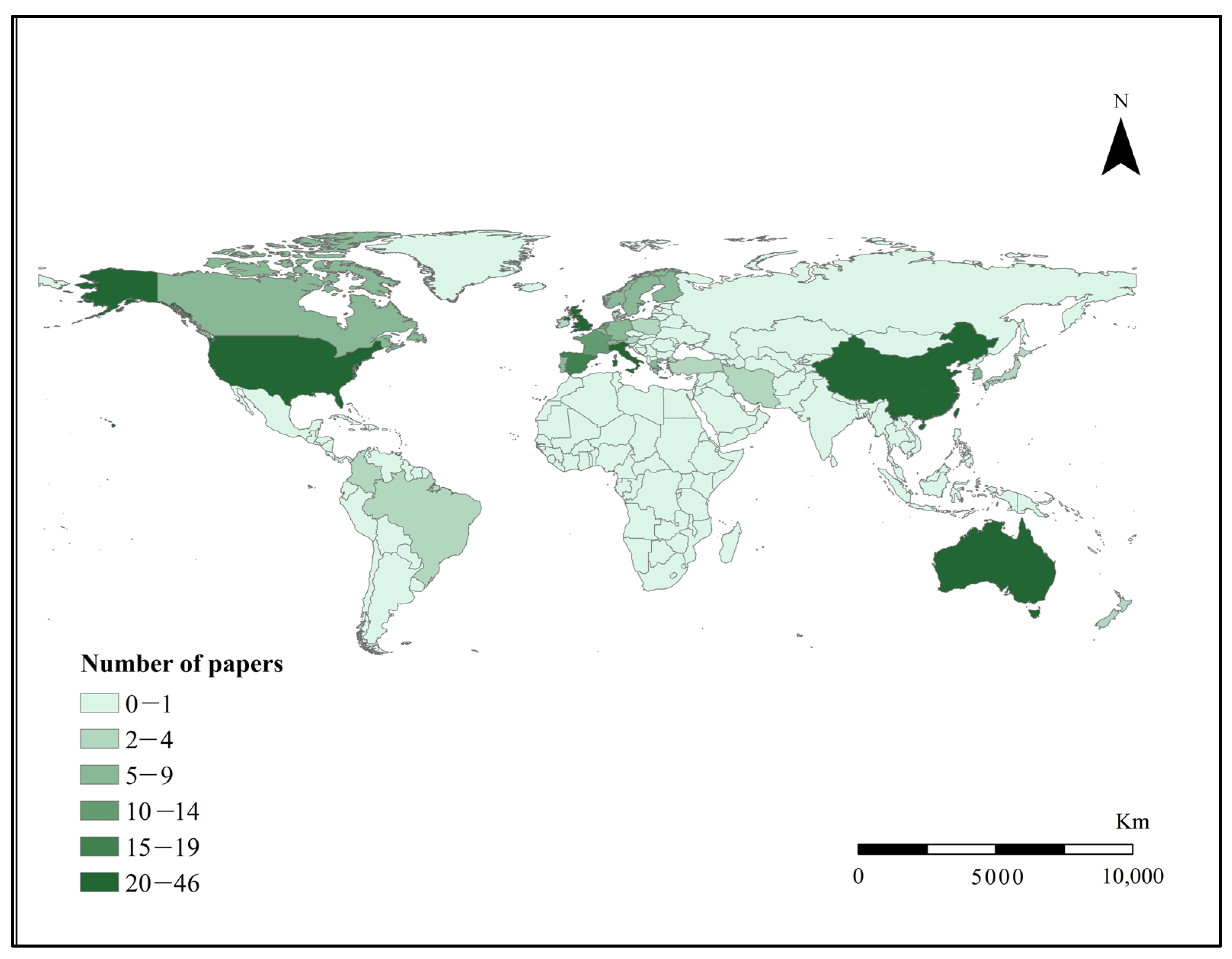
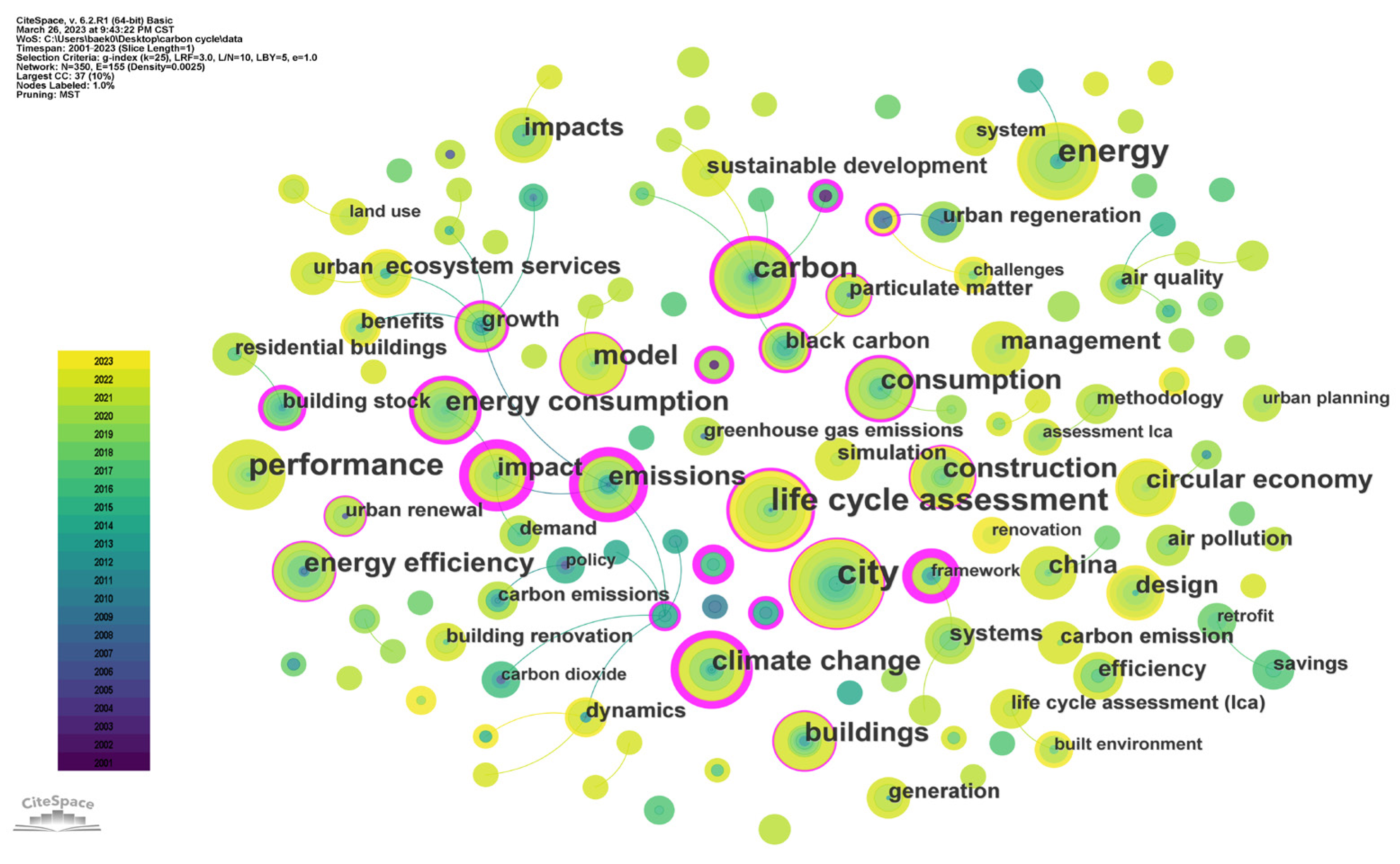
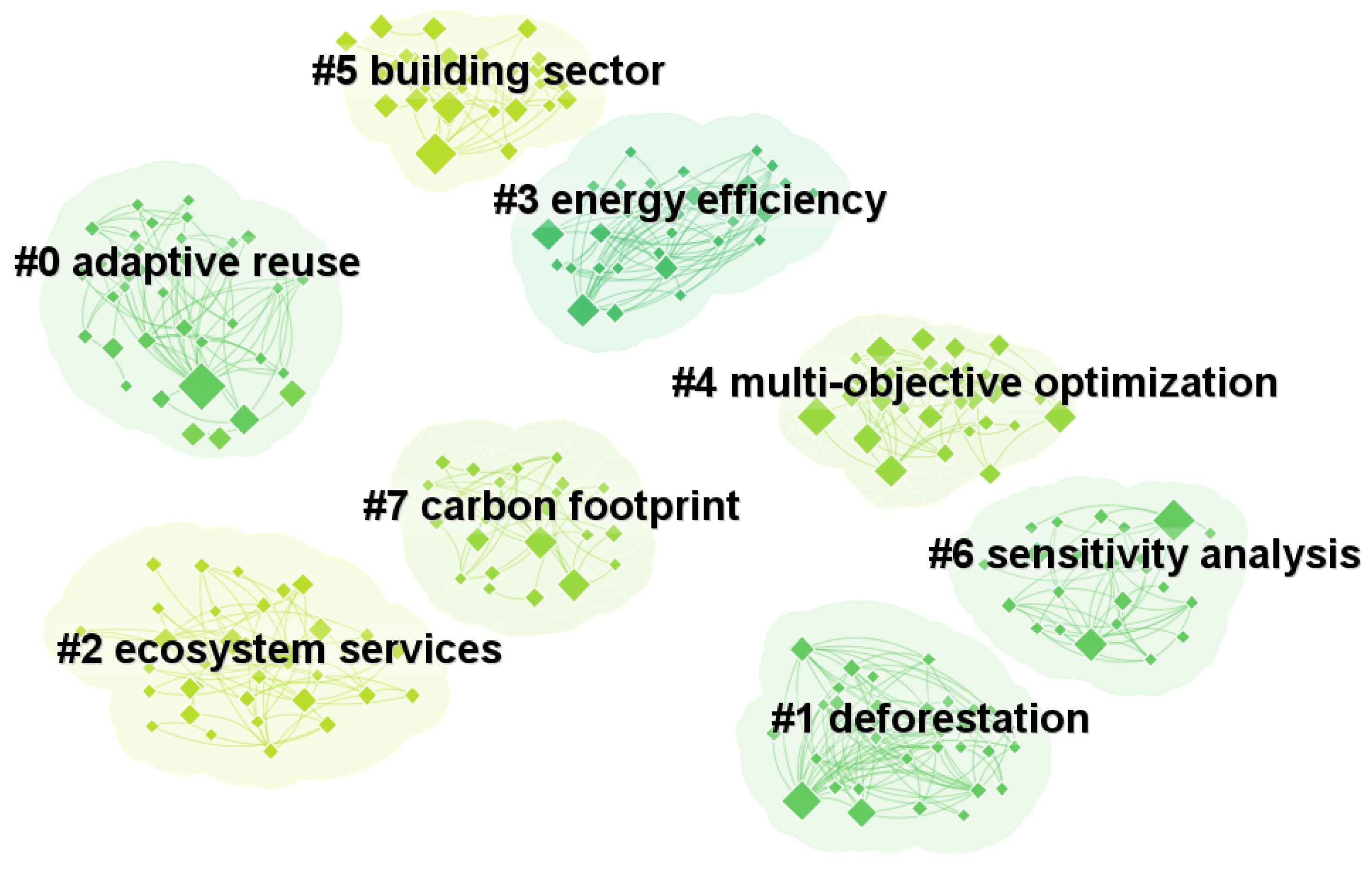

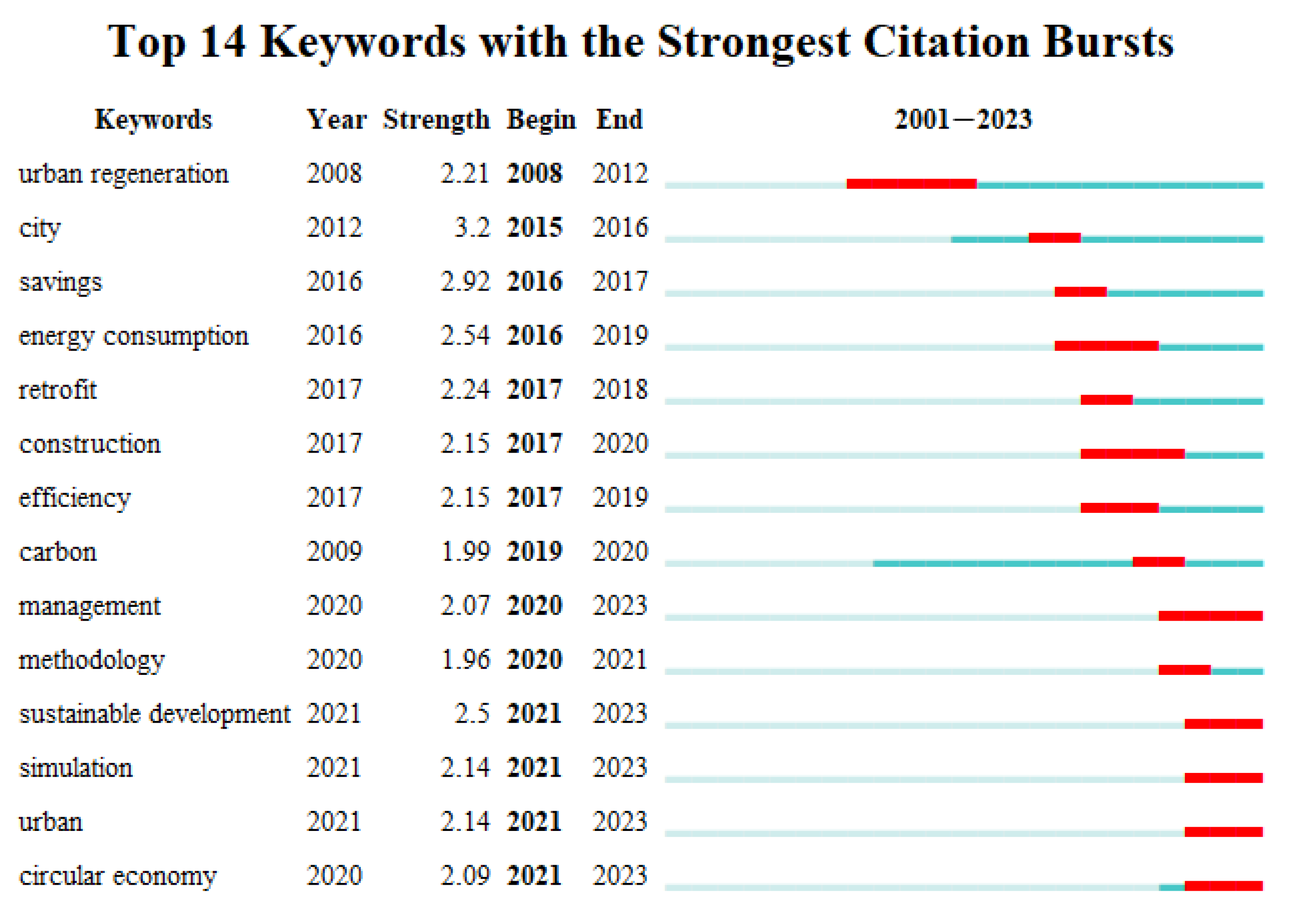
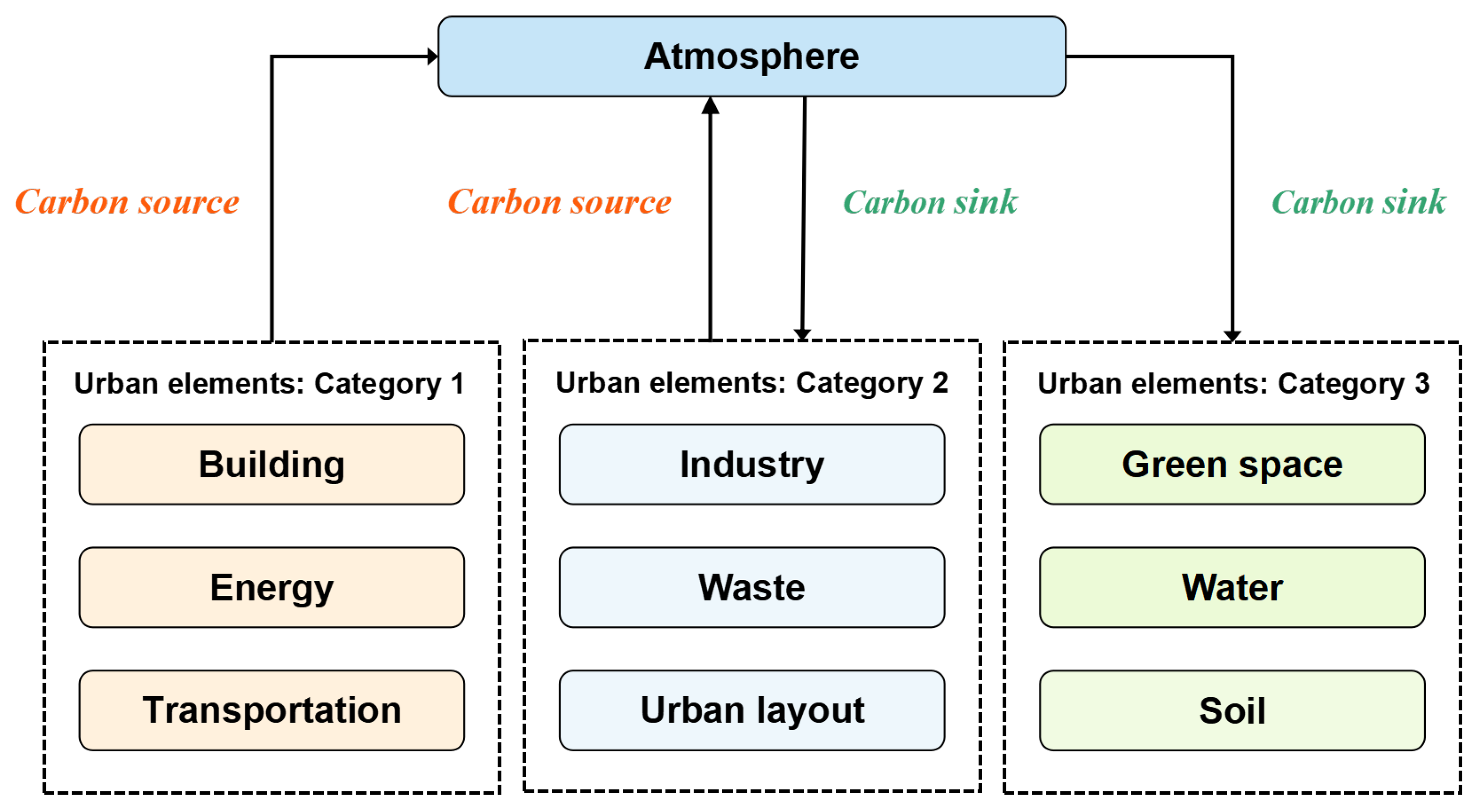
| Paper Title | Authors | Citations |
|---|---|---|
| Need for an embodied energy measurement protocol for buildings: A review paper | Dixit et al. [32] | 537 |
| Does demolition or refurbishment of old and inefficient homes help to increase our environmental, social and economic viability? | Power [33] | 483 |
| A hybrid decision support system for sustainable office building renovation and energy performance improvement | Juan et al. [34] | 418 |
| Implementation challenges to the adaptive reuse of heritage buildings: Towards the goals of sustainable, low carbon cities | Yung and Chan [9] | 398 |
| Thermal upgrades of existing homes in Germany: The building code, subsidies, and economic efficiency | Galvin [35] | 170 |
| Towards nearly zero energy buildings in Europe: A focus on retrofit in non-residential buildings | D’Agostino et al. [36] | 153 |
| Energy performance optimization of existing buildings: A literature review | Hashempour et al. [37] | 100 |
| Category | Elements in the Urban System | Carbon Reduction Strategies in Urban Regeneration | References |
|---|---|---|---|
| 1: reducing carbon sources | Building |
| [60,61,62,63] |
| Energy |
| [64,65,66] | |
| Transportation |
| [67,68,69,70] | |
| 2: reducing carbon sources and increasing carbon sinks | Industry |
| [71,72,73] |
| Waste |
| [42,74,75,76] | |
| Urban layout |
| [64,77,78] | |
| 3: increasing carbon sinks | Green space |
| [79,80,81] |
| Water |
| [82,83] | |
| Soil |
| [84,85] |
| Category | Methodology | References |
|---|---|---|
| Category 1: qualitative | Literature review | [44,74] |
| Case study | [29,89,90] | |
| Semi-structured interview | [69,91] | |
| Category 2: quantitative | Carbon monitoring and accounting | [82,92] |
| Life cycle method | [93,94,95] | |
| Multi-objective optimization | [48,65,96] | |
| Simulation | [87,97,98] | |
| Sensitivity analysis | [99,100,101] |
Disclaimer/Publisher’s Note: The statements, opinions and data contained in all publications are solely those of the individual author(s) and contributor(s) and not of MDPI and/or the editor(s). MDPI and/or the editor(s) disclaim responsibility for any injury to people or property resulting from any ideas, methods, instructions or products referred to in the content. |
© 2023 by the authors. Licensee MDPI, Basel, Switzerland. This article is an open access article distributed under the terms and conditions of the Creative Commons Attribution (CC BY) license (https://creativecommons.org/licenses/by/4.0/).
Share and Cite
Liu, Y.; Sang, M.; Xu, X.; Shen, L.; Bao, H. How Can Urban Regeneration Reduce Carbon Emissions? A Bibliometric Review. Land 2023, 12, 1328. https://doi.org/10.3390/land12071328
Liu Y, Sang M, Xu X, Shen L, Bao H. How Can Urban Regeneration Reduce Carbon Emissions? A Bibliometric Review. Land. 2023; 12(7):1328. https://doi.org/10.3390/land12071328
Chicago/Turabian StyleLiu, Yan, Meiyue Sang, Xiangrui Xu, Liyin Shen, and Haijun Bao. 2023. "How Can Urban Regeneration Reduce Carbon Emissions? A Bibliometric Review" Land 12, no. 7: 1328. https://doi.org/10.3390/land12071328
APA StyleLiu, Y., Sang, M., Xu, X., Shen, L., & Bao, H. (2023). How Can Urban Regeneration Reduce Carbon Emissions? A Bibliometric Review. Land, 12(7), 1328. https://doi.org/10.3390/land12071328







